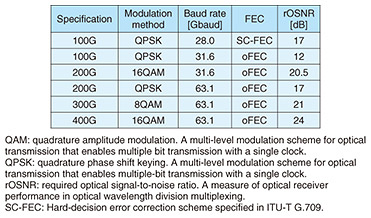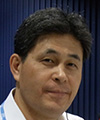 |
|||||||||||||||||||||||||||||
|
|
|||||||||||||||||||||||||||||
|
Feature Articles: International Standardization Trends Vol. 22, No. 1, pp. 18–28, Jan. 2024. https://doi.org/10.53829/ntr202401fa2 Standardization Trends in Technologies Related to Fixed-line NetworksAbstractConfronted by the development of various services, such as cloud computing, fifth-generation mobile communications, telemedicine, and high-definition video transmission, as well as the increase in fixed-line network traffic, international standardization organizations and forums have been expanding the specifications of fixed-line transmission networks and optical components and ensuring interoperability. This article provides examples of NTT’s activities in the International Telecommunication Union - Telecommunication Standardization Sector (ITU-T), International Electrotechnical Commission (IEC), Broadband Forum (BBF), and OpenROADM Multi-Source Agreement. Keywords: fixed-line network, optical fiber, optical connector 1. Overview of international standardization of technologies related to fixed-line networksThe International Telecommunication Union (ITU) is a United Nations (UN) agency and an international standardization organization consisting of UN member states and regions. The ITU Telecommunication Standardization Sector (ITU-T) is a division of ITU. Its work is divided into 11 Study Groups (SGs), each of which focuses on a particular issue or topic. Among them, SG15 (Transport, access & home) is responsible for several technical areas (Questions) related to transmission networks, which are the foundation of telecommunications [1]. This article introduces the international standardization trends in transmission networks and optical component technologies in SG15, including NTT’s involvement in SG15, as well as the activities of a related international standardization organization, the International Electrotechnical Commission (IEC), and related forums, Broadband Forum (BBF) and OpenROADM Multi-Source Agreement (MSA). 2. Trends in transmission network technologyThis section outlines the standardization trends in access, home, metro, and core networks. International standardization of access networks, which are used to provide fiber to the home (FTTH) services, are carried out by ITU-T SG15 Question 2 and the Institute of Electrical and Electronics Engineers (IEEE). FTTH uses a passive optical network (PON) system, which connects an optical line terminal (OLT) located in a telecommunication central office to optical network units (ONUs) located in each user’s home via an optical splitter. Time division multiple access (TDMA)-based PON systems, in which ONUs communicate with an OLT using different time slots, are widely used in Japan, and telecommunication operators have begun to provide 10-Gbit/s-class FTTH services. In 2020, the IEEE 802.3ca Task Force standardized the 25-Gb/s Ethernet Passive Optical Networks (25G-EPON) and 50-Gb/s Ethernet Passive Optical Networks (50G-EPON), which can provide communication services at a maximum transmission rate of respectively 25 and 50 Gbit/s for both uplink and downlink. The 50G-EPON is based on wavelength division multiplexing (WDM) in addition to TDMA and combines two wavelengths, each carrying 25-Gbit/s signals, to achieve a transmission rate of 50 Gbit/s. As part of its work on Question 2, ITU-T SG15 standardized the 50-Gigabit-capable Passive Optical Networks (50G-PON) in 2021. The 50G-PON is based on a conventional configuration, i.e., using a single wavelength to provide a transmission rate of 50 Gbit/s. SG15 is also developing specifications for a configuration based on time and WDM (TWDM), which allows time slots and wavelengths to be flexibly assigned to each user. NTT’s contributions to these efforts include the proposal of a frame structure that assumes an expansion of preamble due to the application of digital signal processing (DSP) and a cost analysis of TWDM-based structure. Furthermore, SG15 is studying a supplemental document that summarizes service requirements and elemental technologies needed for the development of G.VHSP (very high speed PON), which will provide bandwidths in excess of 50 Gbit/s per wavelength, to reach agreement in July 2024. NTT, as a telecommunications carrier, will continue to propose service and technical requirements and lead the discussions. In relation to home networks, SG15 is standardizing, as part of Question 3, optical wireless transceivers that use visible light in addition to wire-line based transceivers that use telephone lines, power lines, coaxial lines, and optical fibers. It is developing standards for transmission technology and overall home network architecture to provide broadband services in the home and other premises, including smart grid applications such as smart meters. SG15 has revised G.9964 to include a new orthogonal frequency-division multiplexing (OFDM) parameter, which reduces subcarrier spacing to improve transmission efficiency in environments where only narrow bandwidths are available for power-line communications. These specifications were proposed by European electric power companies for smart grid applications. At the same time, SG15 standardized the narrowband OFDM power-line communication specifications proposed by another European power company, as G.9901 and G.9903. Systems based on these specifications are already in practical use in Europe. With a view to enabling next-generation optical communications capable of a transmission rate of over 10 Gbit/s by developing a recommendation, G.vlc (visual light communications), SG15 is working on a method of expanding bandwidth by increasing the number of subcarriers as well as use cases and requirements for the standardization of new technologies such as narrow beam optical wireless communication (OWC) transceivers. It has completed the standardization of the system architecture for high-speed indoor transceivers for fiber to the room (FTTR) and continues to discuss the physical, data-link, and control/management layers. During these discussions, SG15 is considering comparisons and interoperability with PON technology in access networks, extensions to the ONU Management and Control Interface (OMCI) protocol based on the transmission quality from the access network to the terminal (Wi-Fi, etc.), and overall architecture for operations and management. Management and control technologies for access networks are being standardized by BBF, which is a global forum intended to promote broadband services and develop system management and control protocol specifications, and interconnection specifications. In recent years, BBF has also been developing specifications for access systems that incorporate virtualization technologies, such as software-defined networks (SDN) and network function virtualization (NFV), as well as specifications for automated management and control. The following describes BBF-specified Automated Intelligent Management (AIM) for automated management and control of access networks. AIM was specified as TR (Technical Report)-436 “Access & Home Network O&M Automation/Intelligence” [2], where O&M is Operation and Maintenance. Figure 1 shows the framework of AIM, which collects the status and information of the target nodes (managed entities) to be managed and controlled, analyzes the appropriate settings, on the basis of its changes, in accordance with a predefined policy, and automatically controls the target nodes. The main functional elements needed to achieve AIM are as follows: (1) AIM Decision Element (DE): Collects status and information of managed entities and analyzes it on the basis of a predefined policy. (2) End-to-End (E2E) AIM Orchestrator and Domain AIM Orchestrator: Sets the analysis policy specified by the carrier in the AIM DE.
The AIM DE is implemented on a virtual resource. The analysis results (new settings) are applied to the target managed entities via the SDN controller. This technology is expected to enable automatic execution of the management and control of access networks such as detection of a fault in an access node and establishment of an alternative path. TR-436 defines the architecture and functional requirements for AIM. BBF is currently studying interface requirements for AIM and extensions to AIM. To support the extensions to AIM, NTT is proposing real-time automatic management control across multiple domains such as optical access networks and wireless access networks. In the area of optical WDM in metro and core networks, the OpenROADM MSA is defining interconnection specifications for open and flexible reconfigurable optical add/drop multiplexer (ROADM) networks. The OpenROADM MSA was launched in 2016. As of August 2023, it has 31 member companies: 16 carriers and 15 optical equipment manufacturers. The aim of the OpenROADM MSA is to achieve open and flexible networks by specifying open standard interfaces, enabling carriers to avoid a lock-in to a specific vendor due to a vertically integrated system, which has been an issue in conventional carrier networks. Figure 2 shows the network structure and interface definitions for a ROADM as envisioned in the OpenROADM MSA. The interconnection specifications being defined by the OpenROADM MSA consist of the specifications of optical transmission interfaces (physical layer) and the application programming interface (API) for controllers. The controller API is specified in a model-driven manner using the Yet Another Next Generation (YANG) model*1. The optical interface specification is available as a spreadsheet document on the OpenROADM website [3]. Regarding the API interface, the latest version of the YANG model is available on the OpenROADM’s Open Git Hub [4]. Whitepapers providing guidelines for the implementations of API models are also available from the OpenROADM website.
In the physical layer, the OpenROADM MSA assumes functional blocks, such as ROADM, X-ponders (transponder, muxponder, and switch-ponder), and in-line amplifier (ILA), and specifies interconnection interfaces between them. The connection of optical WDM transmission signals between a ROADM and ILA is specified as a multi-wavelength (MW) interface. The single-wavelength optical interface for the connection from an X-ponder to a ROADM Add/Drop is called a wavelength (W) interface. Table 1 lists the W specifications (Optical specification ver. 5.1) that have been released. The OpenROADM MSA has established optical specifications that apply oFEC*2, a standardized soft-decision forward error correction (FEC). The supported interfaces use multiple modulation schemes to provide multiple rates in metro optical WDM transmission. According to an open panel discussion held by the OpenROADM MSA, the next-generation Beyond 400G specification is being actively examined.
The OpenROADM MSA has defined three models for the controller control API: service, network, and device. The service model responds to service requests from upper-layer operations systems. The network model converts physical-layer facility information into abstract information and manages the latter as topology information. This allows devices to be replaced without affecting the upper layers. The device model is a template for managing device parameters. It helps enable plug-and-play functions of devices. The Ver. 7.1 of the YANG model can cover the operation of 400-Gbit/s systems in commercial networks. The model is being continuously improved. As of August 2023, the latest release is Ver. 13.1. In its study of the All-Photonics Network (APN), the IOWN Global Forum (IOWN GF, where IOWN is the Innovative Optical and Wireless Network) has selected the specifications of the OpenROADM MSA as candidate specifications. At the same time, IOWN GF identified the functions that the OpenROADM should extend to satisfy the requirements of the APN. NTT is collaborating with other IOWN GF members to discuss extensions to the APN loopback function and remote transponder monitoring function. The device model for the loopback function was published as part of Ver. 13.0 in March 2023. NTT will continue standardization efforts to ensure harmonization between IOWN GF and OpenROADM MSA specifications. In addition to the OpenROADM MSA, ITU-T SG15 is studying, in relation to several Questions, international standards for related technologies, such as optical WDM transmission, time division multiplexing transmission, packet transmission, and synchronous signal transmission for metro and core networks [1].
3. Trends in optical component technologyThis section outlines the standardization trends for the operation and maintenance of optical fiber cables, optical submarine cable systems, and outdoor optical facilities. The main standards for optical fiber cables consist of ITU-T recommendations produced by SG15 and IEC standards produced by IEC Subcommittee 86A (SC 86A: Fibres and cables). ITU-T recommendations help ensure interoperability and quality of service for telecommunications carriers, while IEC standards are widely recognized as de jure standards for the products that make up networks. One of the recent topics worthy of attention is that in its Question 5. SG15, which is in charge of ITU-T recommendations related to optical fibers, agreed on a technical report on space division multiplexing (SDM) optical fiber cables in September 2022 [5]. This technical report comprehensively describes the technical maturity of and issues with the SDM optical fibers shown in Fig. 3. It is expected to serve as a roadmap for the future international standardization and practical deployment of SDM optical fibers and is widely disseminated through ITU-News and technical flyers.
Optical cable technology has seen a shift from conventional optical fiber ribbons, in which multiple optical fibers are aligned and fixed as shown in Fig. 4(a), to sparsely bonded optical fiber ribbons, in which fibers are partially bonded with an adhesive as shown in Fig. 4(b). The latter has enhanced flexibility in the bending direction. It was proposed and put into practical use by NTT [6] and approved by an IEC standard (IEC 60794-1-31 Optical fibre cables - Part 1-31: Generic specification -), which was released in 2017. Having a simple cable structure, sparsely bonded fiber ribbons enable high-density cable installation similar to the installation of metallic cables [7].
A trend in submarine cables is a growing need to increase the number of fiber cores in cables to meet the demand for boosting the capacity of transcontinental communication systems. There have been intense studies on applying reduced-coating-diameter single-mode fiber (SMF) cables, the coating diameter of which is 200 μm (with 125 μm cladding) compared with 245 μm of the SMF cables that have been conventionally used for submarine long-distance transmission. To support the practical deployment of reduced-coating-diameter SMF cables, IEC is revising the related IEC standard (IEC 60793-2-50: Optical fibres - Part 2-50: Product specifications - Sectional specification for class B single-mode fibers). The revised document is scheduled to be published in fiscal year 2024. It is expected that optical fiber cable technology will see progress in the studies of high-density and high-capacity cables using SDM based on technologies for sparsely bonded fiber ribbons, multi-core fiber (MCF), and reduced coating diameter. A joint task force involving the World Meteorological Organization (WMO) and United Nations Educational, Scientific and Cultural Organization (UNESCO) is studying the use of optical submarine cable systems for optical sensing, such as ocean monitoring and earthquake detection [8]. To achieve this, ITU-T SG15 Question 8 is working on two new ITU recommendations, one for submarine cable systems dedicated to sensing and the other for submarine cable systems used for both communications and sensing. The recommendations are expected to be approved in 2024. These sensing systems measure temperature, pressure, and acceleration and are expected to be used to detect earthquakes and tsunamis and collect information on climate change. The maintenance and inspection of outside optical facilities had been left to each carrier’s own operational scheme. However, with the widespread adoption of optical communications, it is growing in importance as a social infrastructure, resulting in a heightened interest in sustainable and efficient operation of outside optical facilities. ITU-T SG15 Question 7 agreed to systematically develop an international standard for the inspection of outside optical facilities based on an NTT’s proposal. In 2020, Recommendation L.330 (Telecommunication infrastructure facility management) was approved, which defines 17 outside optical facilities to be inspected as well as the requirements for and flow of basic inspection tasks. This recommendation exhaustively presents guidelines on inspection frequency, inspection items, and the level of accuracy of measuring degrading events required at the time of precision inspection. In 2023, the revision of Recommendation L.340, which describes specific methods of inspection, related technologies, and safety issues for inspection work in underground telecommunication facilities, was completed. It is expected that the development of new recommendations and revision of existing recommendations will continue on issues related to the maintenance of aerial facilities and conduits attached to bridges. In addition, ITU-T SG15 Question 7 is revising Recommendation L.250 (Optical access network topologies for broadband services) to define requirements for wiring topologies used to provide network services, including those other than FTTH, such as centralized radio access networks. Considering that a reliable access topology is indispensable to meet various network service requirements, SG15 is expected to incorporate a concatenated loop topology for optical access networks [9] in L.250 as an effective means of ensuring reliable redundant paths throughout the service area. Optical connectors are used in a wide variety of applications, such as interfaces for optical communication devices, optical measuring instruments, and optical communication services in addition to connecting optical cables in optical transmission networks. Since it is necessary to make it easy for anyone to connect and disconnect optical connectors no matter who the manufacturers are, international standardization is essential to guarantee the compatibility of optical connectors. International standardization of optical connectors is mainly carried out by IEC SC 86B (Fibre optic interconnecting devices and passive components). As of August 2023, among the 187 committees in IEC, SC 86B boasted the largest number of published documents and was the fifth in terms of the number of working documents, indicating how intensively optical connectors are being standardized in response to the recent expansion of optical communications. NTT has been leading the world in commercial deployment of optical networks and developed and standardized many optical connectors required for this deployment. Among these connectors, the single-fiber coupling (SC) and multi-fiber push-on (MPO) connectors developed in 1986 and 1991, respectively, are particularly easy to handle and highly compatible, with the result that they are now the most widely used single-fiber and multi-fiber connectors in the world. In 2021, they received the IEEE Milestone Award, which is conferred on historical achievements that have made significant contributions to the development of society. The main points of the standardization of optical connectors are described below based on the structures of SC and MPO connectors shown in Fig. 5. In optical communication systems, the optical loss and return loss*3 that are allowed in optical connectors are specified. It is generally required that the optical loss be 0.5 dB or less and the return loss be 40 dB or more. The loss in optical connectors mainly depends on the core misalignment, so the core misalignment must be 0.75 μm or less if we are to achieve an optical loss of 0.5 dB or less. This is so stringent that no elastic deformation of the component due to external forces is tolerated. To satisfy this requirement, optical connectors have a double engagement structure, as shown in Figs. 5(b) and 5(d): the engagement of extremely high-precision parts called ferrules and the engagement of the housings, which are needed for stable connection. While connectors are engaged, the ferrules are pressed against each other by the spring built into the plug housing to maintain the engaged state. The engaged plug housings and adapter housings protect the ferrule-engagement parts from external forces and prevent the optical loss from changing due to elastic deformation of the ferrules. The return loss of an optical connector is highly dependent on the Fresnel reflection*4 at the connection point of the connector. Since a large Fresnel reflection arises at the boundary plane between glass and air, the cores must be in tight contact with each other so that no air is present between the cores (physical contact (PC) connection) if we are to achieve a return loss of 40 dB or more. To establish a PC connection, the ferrule end faces are polished to a spherical shape so that the cores contact each other easily. To guarantee connection compatibility in the above connector structure, the following four items must be specified, as shown in Table 2: (1) ferrule dimensions, (2) housing dimensions and spring force, (3) performance of optical connector products, and (4) test procedures to confirm that the above three specifications are met. As mentioned above, a ferrule is a component used for axial alignment of an optical fiber core. Therefore, (1) ferrule dimensions must be specified for each optical fiber type, even if the ferrules are of the same type. However, (2) housing is specified for each connector type. (3) Connector performance is specified for each application. On the basis of this technical background, IEC has adopted a documentation system in which an optical connector product is specified by combining three documents, respectively related to (1) type of optical fiber to be connected, (2) connector type, and (3) application. They correspond to the following documents: (1) optical compatibility standard (IEC 61755 and 63267 series), (2) engagement standard (IEC 61754 series), (3) performance standard (IEC 61753 series), and (4) testing procedures (IEC 61300 series).
Lastly, let us present the latest trends in standardization. There has been intense research and development on SDM optical fibers capable of high-capacity transmission exceeding that of SMF. Anticipating forthcoming practical application of MCF, NTT has started standardization work on MCF connectors. On the occasion of revising the document on optical-connector testing procedures (IEC 61300 series), we are adding MCF connector tests. As the first step, a measurement procedure for MCF connectors was added to the loss measurement procedures (IEC 61300-3-4:2023), which were revised this year (2023). Standardization of single-core connectors has also started for 4-core MCFs with a clad outer diameter of 125 μm, which are products closest to practical application. Figure 6 shows an overview of a 4-core MCF. As mentioned above, only the ferrule dimensions need to be specified for each optical fiber type. However, since the optical fiber for 4-core MCFs has not yet been standardized, the amount of core-axis misalignment as part of the ferrule dimensions cannot be specified at this time. Since the conditions for the spherical shape to achieve PC connection have been reported [10], a public specification that specifies only the end-face shape will be released within this year based on this report. As shown in Fig. 6, a 4-core MCF requires tight contact of wider end faces, making the end-face shape requirements more stringent than ever. Consequently, it may become necessary to change the ferrule end-face polishing process. SC 86B is seeking to accelerate the early practical use of 4-core MCF connectors by making the ferrule end-face shape specifications public.
4. Future outlookIn the coming years, fixed-line transmission networks, along with optical components, will play an increasingly important role as a high-capacity infrastructure for providing various services, such as those envisioned with IOWN. Therefore, there are high expectations that extensions to specifications and promotion of common specifications by international standardization organizations and forums will shorten development time and ensure interoperability. NTT will continue to work actively on international standardization in the field of fixed-line transmission networks to meet diverse service requirements. References
|
|||||||||||||||||||||||||||||
























